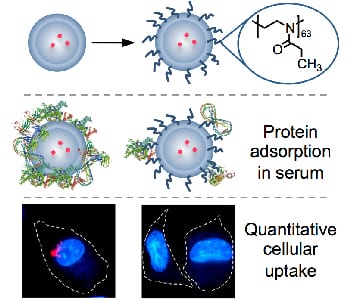Nanoparticles hold great promise in the field of nanomedicine, especially for targeted drug delivery. Functional drug carriers should be able to transfer the drug to the diseased area and release it there without damaging healthy tissue. However, the delivery success of nanoparticles still remains far below expectations as revealed by a recent survey of the literature from the last decade: only 0.7% (median) of the administered nanoparticle dose is found to be delivered to a solid tumor.
One of the reasons for this low success is that nanoparticles interact with proteins in the biological environment, due to their large surface-to-volume ratio. This leads to the formation of a protein corona. The protein corona can promote the recognition of nanoparticles by the immune system and consequently causes their removal from the body before the particles reach their target. To avoid an undesired protein adsorption, it is necessary to mask nanoparticles and prevent them from interactions with proteins.
 Poly(2-oxazoline)s are known for several years to be able to increase blood circulation times of colloidal particles. However, their ability to actually prevent the protein adsorption to mask particles of less than 100 nm in size has not yet been investigated. In a collaborative project, researchers from Fraunhofer ICT-IMM and from the Universities of Mainz and Potsdam demonstrated that a coating with biocompatible poly(2-ethyl-2-oxazoline) (PEtOx) can efficiently prevent protein adsorption on nanoparticles smaller than 50 nm. Additionally, they also showed that PEtOx coating can reduce non-specific cellular uptake by phagocytic immune cells, which are responsible for the removal of nanoparticles from the blood stream.
Poly(2-oxazoline)s are known for several years to be able to increase blood circulation times of colloidal particles. However, their ability to actually prevent the protein adsorption to mask particles of less than 100 nm in size has not yet been investigated. In a collaborative project, researchers from Fraunhofer ICT-IMM and from the Universities of Mainz and Potsdam demonstrated that a coating with biocompatible poly(2-ethyl-2-oxazoline) (PEtOx) can efficiently prevent protein adsorption on nanoparticles smaller than 50 nm. Additionally, they also showed that PEtOx coating can reduce non-specific cellular uptake by phagocytic immune cells, which are responsible for the removal of nanoparticles from the blood stream.
A direct comparison showed that poly(2-oxazoline)s are a good or even superior alternative to the current gold standard for stealth coating of nanoparticles against proteins, poly(ethylene glycol) (PEG). Thus, PEtOx could be a promising candidate to be used for the better design of drug delivery systems with increased efficiency.

















